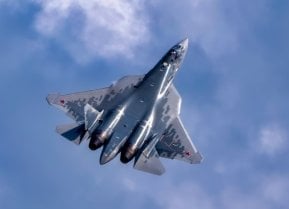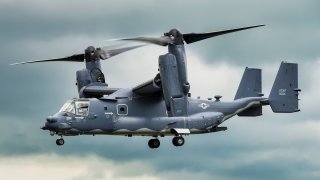The V-22 Osprey Is Just Getting Started for the U.S. Military
The V-22 Osprey aircraft is capable of carrying up to thirty-two troops or 10,000 pounds of cargo, while it is seen as a robust and flexible platform.
In March, the Naval Air Systems Command cleared the tiltrotor V-22 Osprey to return to flight, after the aircraft had been grounded since early December 2023 following a crash of a U.S. Air Force V-22 off the coast of Japan that killed eight airmen. The sea service had also grounded the aircraft after Air Force officials investigating the Japan crash found “a materiel failure of a V-22 component.”
Per the Pentagon, lifting the grounding allowed the aircraft in service with the U.S. Air Force, U.S. Marine Corps, and U.S. Navy to return to service.
“This decision follows a meticulous and data-driven approach prioritizing the safety of our aircrews,” a Navy official said in March, according to a release from the Department of Defense (DoD).
An Important Aircraft Will Remain in Service For Decades
As previously reported by Stavros Atlamazoglou for The National Interest, “The V-22 Osprey, a unique tiltrotor aircraft of the U.S. military, combines the vertical takeoff and landing capabilities of a helicopter with the speed and range of a jet. It serves as a primary air assault platform for the U.S. Marine Corps and supports special operations globally.”
Although fifty servicemembers have lost their lives in accidents over the past thirty years—including twenty in accidents over the past two years—the V-22 is seen as irreplaceable, at least in the near term.
The aircraft is capable of carrying up to thirty-two troops or 10,000 pounds of cargo, while it is seen as a robust and flexible platform. Plans are underway to see the V-22 eventually replaced by the Bell V-280 Valor, but that could be years away.
Now, the Pentagon is determining how to keep the Osprey flying safely.
As first reported by Defense News, U.S. Marine Corps colonel Brian Taylor, the joint program manager for the aircraft, told an audience at the Modern Day Marine conference in Washington, DC, last week that the U.S. military will introduce upgrades that will allow the V-22 to fly through 2050 and beyond.
Taylor said that the U.S. military is the only one flying a tiltrotor because it’s a complicated plane with a complicated drive system.
The V-22 Osprey program office is now focused on the V-22 Cockpit Technology Replacement (VeCToR), an upgrade effort that will begin research and development in 2026 and could be fielded from 2032 to 2042. It would bring more off-the-shelf technology to the screens, keyboards, computers, and radars in the cockpit, while the office is also in the early stages of studying a Renewed V-22 Aircraft Modernization Program (ReVAMP) effort that would consider how to keep the fuselage for decades beyond what would otherwise be the end of the plane’s effective life in the early 2060s.
Taylor said at the conference that the V-22 effort is still in its infancy, but the office is now soliciting ideas and input from industry to shape the effort. The program office has considered an optionally unmanned version, but the focus is to make the aircraft more reliable, maintainable, affordable, and safe.
To that end, the services are exploring how the proprotor gearbox and drive system can be improved. According to Defense News, Taylor said a new input quill assembly prototype that incorporates fifteen design changes could be delivered soon, with testing following. There would be changes to the gearbox, to address “chipping”—where metal shavings come off during routine operations, which can result in damage to the rest of the drive system.
Author Experience and Expertise
Peter Suciu is a Michigan-based writer. He has contributed to more than four dozen magazines, newspapers, and websites with over 3,200 published pieces over a twenty-year career in journalism. He regularly writes about military hardware, firearms history, cybersecurity, politics, and international affairs. Peter is also a Contributing Writer for Forbes and Clearance Jobs. You can follow him on Twitter: @PeterSuciu. You can email the author: [email protected].
Image Credit: Shutterstock.


